Capturing and storing CO2 from the atmosphere in a safe and permanent manner is an essential step in reducing atmospheric CO2. What and where are the most efficient ways to do this and can the methods be scaled up to help reduce the global concentration of atmospheric CO2?
Sequestering carbon dioxide with nickel and diamond mine tailings
Sterling Vanderzee, PhD Candidate

I am excited about working with real companies and communities to help develop and implement new technologies for reducing the greenhouse gas emissions from industrial activities.
Research
The goal of my research is to reduce the greenhouse emissions from nickel and diamond mining operations. We do this by using the magnesium-rich waste solid products of mining, called mine tailings, to convert carbon dioxide (CO2) gas into solid magnesium-carbonate minerals. Mine tailings are essentially the finely ground rocks that remain after the nickel and diamonds have been removed. The trick to this process is being able to identify highly CO2-reactive rocks within the mine, so that the tailings generated from these rocks can be targeted for use as feedstock for sequestering CO2. By using the most CO2-reactive rocks we can sequester CO2 more rapidly and do it without having to use any chemicals or expensive and energy-intensive technologies that require high temperatures and/or high pressures. The CO2-reactive mine tailings can naturally remove CO2 from the atmosphere, and also capture it from the CO2-rich exhaust gases produced by onsite diesel electricity generators. Most of my research involves “treasure hunting” for these highly CO2-reactive rocks through data analysis and quantifying the carbon sequestration potential of different mines and mineral deposits.
References
Vanderzee, S.S.S., Dipple, G.M., and Bradshaw, P.M.D. (2019) Targeting Highly Reactive Labile Magnesium in Ultramafic Tailings for Greenhouse-gas Offsets and Potential Tailings Stabilization at the Baptiste Deposit, Central British Columbia (NTS 093K/13, 14). Geoscience BC Summary of Activities 2018: Minerals and Mining, 109–118.
In order to transition off fossil fuels for our energy needs without reducing the global standard of living, we must mine more material out of the Earth than ever before. Minerals that contain iron, nickel, copper, lithium and others are needed for batteries, wind turbines, solar panels and many more products and infrastructure that facilitate the transition from fossil fuels. How can we meet these global demands for raw materials in a sustainable way?
Numerical modeling of mine waste and carbon sequestration practices
Katherine Raymond, Research Scientist

I became a hydrogeologist because I was passionate about protecting the earth since I was a kid and first learned about climate change in elementary school. When I started university, I knew I wanted to do something related to protecting water as a resource, but I didn’t actually learn about what hydrogeology was until my first year at the University of Waterloo. Through a bit of serendipity, I had a professor who told me what it was and encouraged me to switch degrees (from Environment and Resource Studies), and I am happy I did!
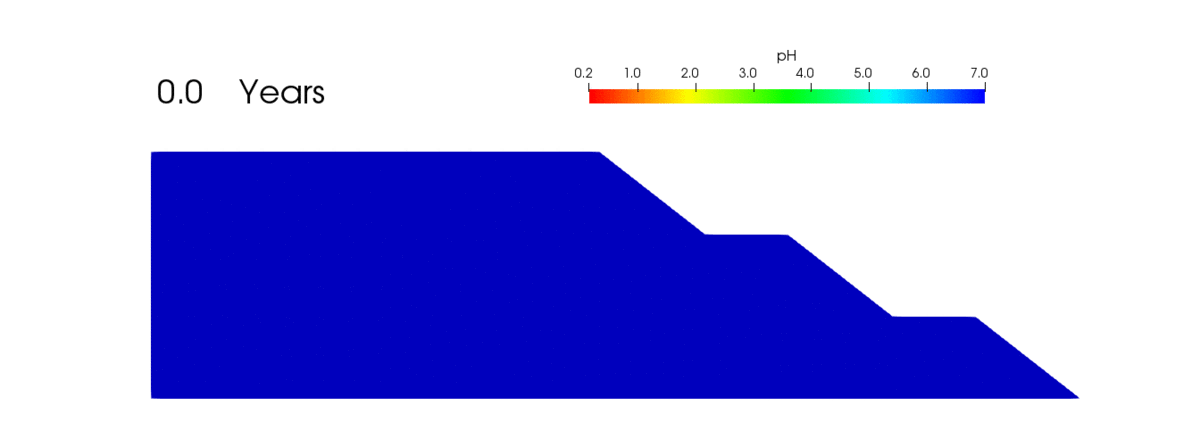
Animation showing changes in pH (measuring acidity and potential metal leaching) in a conceptual waste rock over 50 years produced using the reactive transport model MIN3P.
Research
In order to extract valuable resources such as metals and gems, mines must remove massive amounts of non-valuable rock (referred to as “waste rock”) to reach them. These piles are often stored above ground and may be up to 500,000,000 m3 of rock (a volume which could fill 200,000 Olympic-sized swimming pools). Additionally, some of these materials are mixed with other chemicals and broken down into small particles during mineral extraction (called “tailings”), which must also be stored. Similar to the mechanism of rust forming on iron, when removed from the ground and exposed to oxygen in the air, waste rock may break down and release potentially harmful metals, which then require water treatment if poorly managed.
My previous research focused on storage design strategies for waste rock piles in order to minimize contaminant release and water treatment requirements. I do this by using computer models to help conceptualize what is happening within these piles and to improve long-term waste rock storage design strategies. I have recently joined the CarbMin group, where I hope to apply these modeling techniques to investigate how to enhance CO2 sequestration (i.e. taking CO2 out of the atmosphere where it acts as a greenhouse gas and storing it as a mineral/solid phase).
This research excites me because it feels like there is so much to discover. Numerical models are tools to help you solve your scientific questions and quite engaging; you have to know and input all the components that go into the model to make it produce realistic results, and in return, the model gives you images of what processes are happening below the surface which we normally cannot see (or try to see through very limited data points).
This research is also important because “If it can’t be grown, it must be mined”. Even for more sustainable energy sources and products, we will continue to rely on metals extracted from the earth to move forward into the future. Understanding how to responsibly manage the waste produced from mining activities is an essential part of our sustainable future and protecting the land and water for future generations. Building carbon sequestration goes beyond that; not only making a necessary industry (mining) more sustainable, but actually teaming up with the industry to help combat climate change as we extract materials using better techniques to improve our society. This work feels like a necessary step to improve society, and is extremely rewarding in that regard!
The development and use of different types of renewable energy, such as hydroelectric, solar, wind and geothermal power, are important for the global transition from fossil fuels as the primary source of energy. As renewable energy becomes the dominant source of energy, strategies for generating renewable energy more efficiently grow in importance. Can we increase the efficiency of renewable energy generation by improving weather models and predictions of ideal locations for alternative energy infrastructure?
Economic value of weather forecasts for run-of-river hydropower systems
Abhinab Kadel, MSc Candidate in Atmospheric Science

My background is in renewable energy. As the raw materials for renewable energy is highly dependent on weather, I was interested in learning more about weather forecasting. Currently, I am a member of the UBC Weather Forecast Research team, and in collaboration with The International Centre for Integrated Mountain Development (ICIMOD), Nepal. In terms of challenges towards progress on climate action, I expect there to be increasing pressure on UBC to ensure that there is good quality of services without increasing the carbon footprint drastically as incoming student numbers increase every year. The Climate emergency declaration and formation of Climate Emergency Advisory Committee are good first steps to address this challenge.
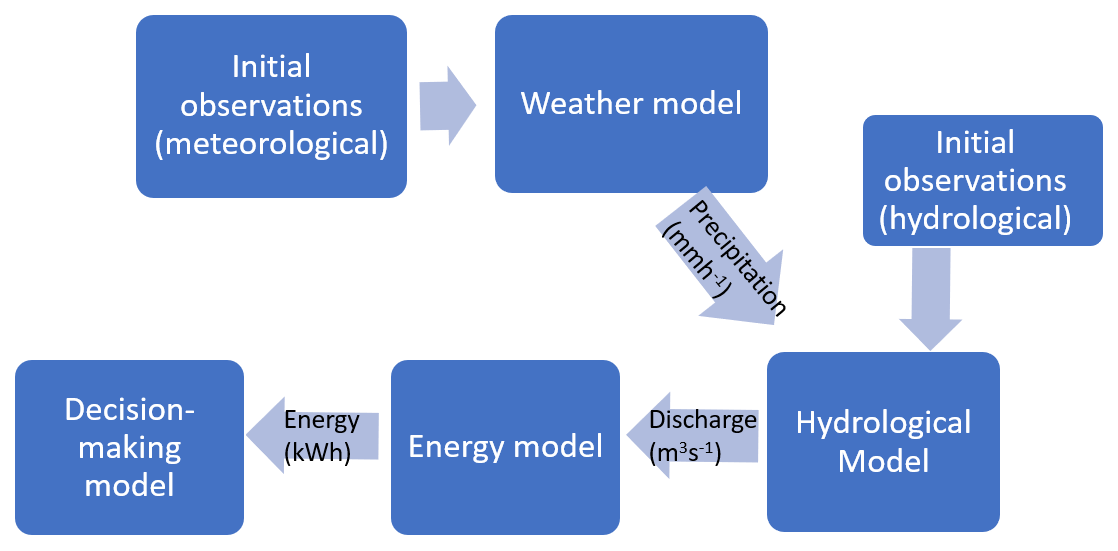
Research
The raw materials for renewable energy generation are highly dependent on weather, thus weather forecasting plays a key role in renewable energy systems. My research combines interdisciplinary concepts in engineering, weather forecasting and energy economics to predict water discharge values in run-of-river hydroelectric systems. River discharge forecasts are obtained from the streamflow forecasting tool developed by International Centre for Integrated Mountain Development (ICIMOD)1. It provides forecasts using 52 different possible scenarios. The maximum and minimum values of river flow using these different scenarios are provided for 10 days into the future. Such weather forecasting products are widely used by hydropower operators such as BC Hydro2. However, they are not yet used in Nepal.
Unlike BC, Nepal has a majority of electricity generation through run-of-river hydro systems. Run-of-river systems have a smaller barrier on a river or stream to divert water towards turbines. A weir does not create a lake like conventional dams do. Hence, there are limited strategies to control water flow. As there are limited possibilities for water management, I am focusing on evaluating how the forecasts could be used for different electricity markets in Nepal. The focus will be on wholesale electricity markets, i.e., trading arrangements between electricity producers and the utility. For example, the current market provision in Nepal is to have power purchase agreements that guarantee fixed rates per energy yield for 25-30 years. My research aims to explore the utility of inflow forecasts for other market scenarios such as day-ahead trading, where hydropower operators need to declare beforehand the amount of electricity they plan to sell to the utility.
Renewable energy sources like hydroelectric power generation provide an alternative to fossil fuel-based economy. Unlike nuclear and fossil fuel sources, which are highly location and technology dependent, renewable energy sources are modular, making them ideal for developing economies. Probability forecasts aim to minimize the uncertainty associated with renewable generation, expanding their integration possibilities in a community.
References
1Boucher, M.A. & Ramos, M.H. (2018) Ensemble Streamflow Forecasts for Hydropower Systems. Handbook of Hydrometeorological Ensemble Forecasting, pp 1-19
2ICIMOD, https://servir.icimod.org/science-applications/streamflow-prediction-too.... Accessed: Feb 10, 2021
Ice covers ~10% of the Earth’s surface, as sea ice on the ocean and as glaciers on land. Global ice coverage is decreasing due to climate change which, in turn, is disrupting freshwater supply. It will also cause sea levels to rise and ocean currents to change in ways that could accelerate climate change further. How will glaciers and ice sheet recession in the coming decades impact our climate, our water resources and habitation in high elevation valleys?
Glaciers and Ocean Ecosystems in the Canadian Arctic
Stephanie Waterman, Assistant Professor and Oceanographer

I became an oceanographer because, at the time, I saw physical oceanography as a cool application of my love of physics that I could relate to (unlike quantum mechanics which to me was much too abstract). It also provided exciting opportunities to travel and have awesome adventures doing fieldwork. Today, I am motivated by the importance of understanding how the Earth system works so that we can better chart our course to a sustainable future that better manages and protects Earth’s natural systems. I think the biggest challenge toward climate progress lies in accelerating our timelines for climate action. In recent years, there have been many positive changes in the attitudes and ambitions of institutions at many levels with respect to taking action on climate change. However, I believe it is imperative to make progress at a faster rate. The attitudes and ambitions of younger people (like the students I teach at UBC) give me hope. I am inspired by their commitment to positive change with respect to sustainability but also climate justice issues.
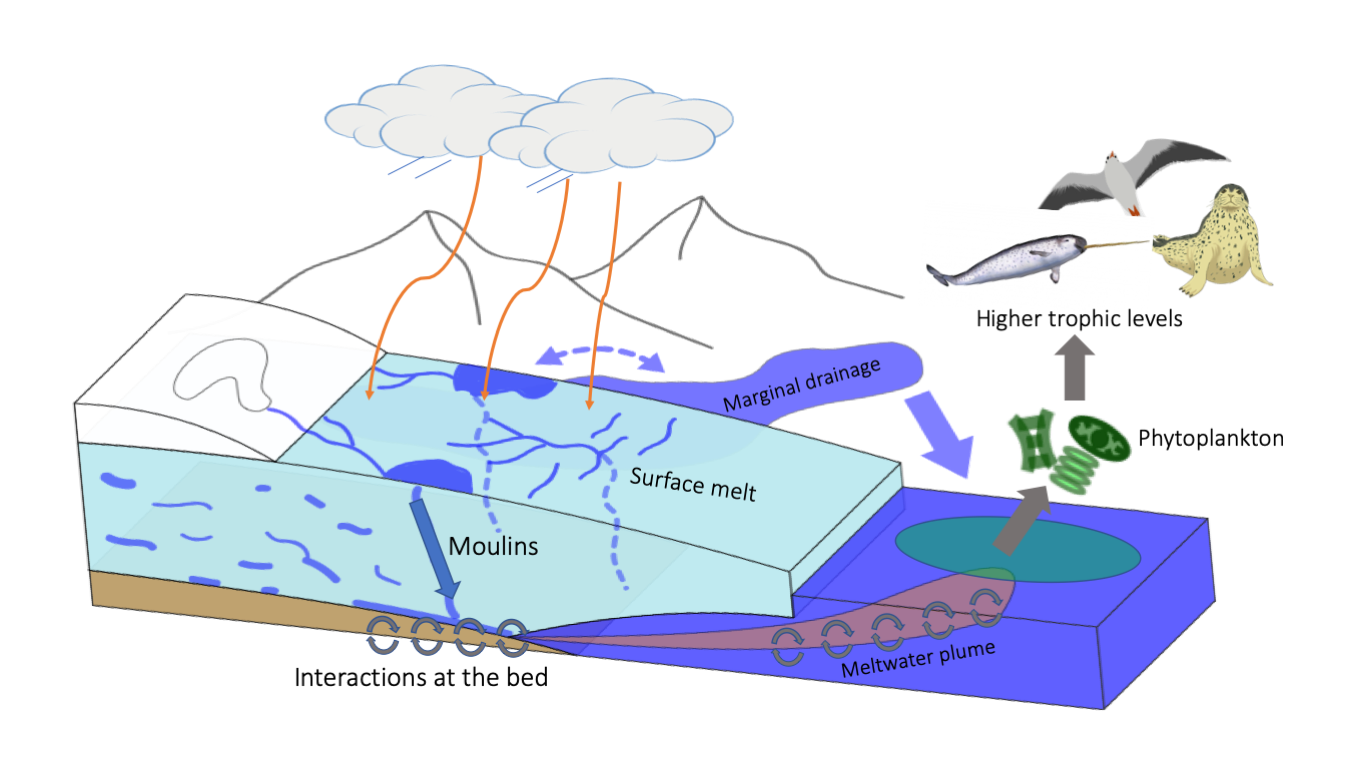
Figure: How does glacial meltwater impact marine life? Glaciers are dynamic systems that pick up nutrients and minerals as the glacier moves and melts. Meltwater enters the ocean from the base of the glacier, below the ocean surface. As this meltwater plume rises, it can bring up both nutrients and minerals in the meltwater as well as deeper seawater that is rich in nutrients. Thus, marine-terminating glaciers might be playing an important role in supporting marine productivity in Jones Sound in the Canadian Arctic Archipelago. This would be consistent with traditional knowledge from Inuit communities which indicates that the waters around glaciers that terminate in the ocean are particularly rich in wildlife.
Research
Glaciers are melting at an alarming rate. The Canadian Arctic Archipelago (CAA) is a hotspot for such melting, and the resulting meltwater has important impacts on marine ecosystems via mechanisms that are poorly understood. In our project, we aim to understand how glacial meltwater impacts Arctic marine ecosystems, including the humans they support. To do so, we make measurements of ice, glacier meltwater and the ocean waters surrounding melting glaciers in order to understand how glacier meltwater impacts nutrients and primary production in coastal waters near ocean-terminating glaciers. We also perform laboratory experiments to better understand how plankton in these environments respond to inputs of glacier meltwater. Finally, we partner with community members of the Inuit Hamlet of Ausuittuq (Grise Fiord) to document and leverage Indigenous knowledge of timing and locations of glacially-driven increases in marine productivity.
Our measurements show that marine waters fed by tidewater glaciers in the Canadian Arctic have elevated nutrient concentrations, and that some types of nutrients are delivered directly by the glacial discharge while others are sourced from deeper marine waters delivered to the surface ocean by upwelling associated with the rising glacial meltwater plume. Further, they suggest that the volume of meltwater determines the amount of nutrients brought to the surface by upwelling. This is important because it suggests that in the future, as glaciers in this region retreat, we expect coastal waters along the archipelago to become less nutrient-dense.
We will leverage our work to empower Northern communities to direct and participate in assessing, understanding and adapting to environmental change. I am most excited by project partnerships with community members of the Inuit Hamlet of Ausuittuq (Grise Fiord). Located on Ellesmere Island NU, the Hamlet is directly impacted by the recent acceleration in CAA glacier melt and its influence on marine ecosystems as community members depend on their local marine environment for traditional harvesting of wildlife for food, resources and, more recently, for attracting tourism. The community has recently expressed interest in understanding the impacts that climate change, and enhanced glacial melting in particular, are having on the marine ecosystems they depend upon. A full-time resident of the Hamlet, Jimmy Qaapik, who has guided scientific expeditions for the Government of Canada’s National Glaciology Monitoring Program for several decades, is a formal co-investigator on our project. Qaapik enables us to incorporate Indigenous knowledge at all stages of our study and helps to ensure significant long-term benefits are created for the Hamlet from this project. Together we aim to develop best practices for the empowerment of Indigenous coastal communities to participate in the monitoring and management of their local ecosystems during a time of extreme change.
References
https://apecs.is/research/polar-and-alpine-research-areas/76-earth-scien...
https://www.theglobeandmail.com/canada/article-new-ways-forward-in-canad...
Local and global changes in weather patterns will affect the availability of fresh water across the world as precipitation events and droughts become more severe and mountain glaciers recede. How will fresh water availability change in the next hundred years for various regions?
Carbon and water fluxes from different land-uses in the state of Mato Grosso Brazil
Brenda D’ Acunha, PhD Candidate

I have always been interested in the interaction between the atmosphere and the biosphere. I am specially curious about how climate change, deforestation, and land-use change can alter carbon fixation, water fluxes and even regulate the climate. I want to understand these processes, their main patterns, what drives them, how are they changing, and also what we can do to mitigate the impacts of different human activities on the environment. The main challenges I see for climate are turning recommendations into concrete actions and implementation plans. What gives me hope is that UBC has declared that tackling climate change and reducing carbon emissions will be a priority. I also think that it’s good that they are trying to build bridges and encourage dialogue between all the actors, so that proposed solutions include voices from underrepresented communities, and the process is equitable, transparent and just.
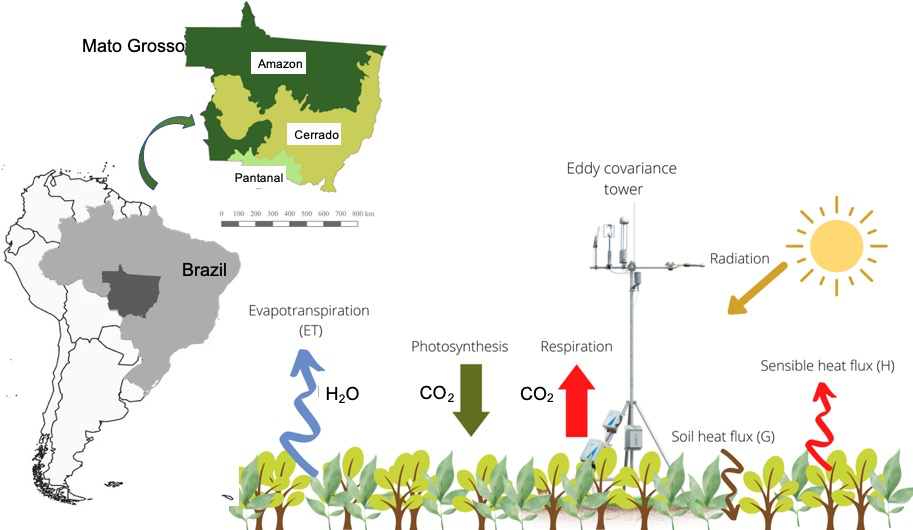
Research
My research focuses on studying carbon, water and energy fluxes from natural and managed ecosystems in the state of Mato Grosso (MT), Brazil. MT contains three biomes: The Amazon rainforest to the north, the Cerrado or savanna in the center, and the Pantanal, the world’s largest continuous wetland, to the southwest. Over the last years, the state has turned into the agricultural powerhouse of the country, and now contains about a third of Brazil’s grain production1. However, this rapid growth has led to several impacts on the ecosystems services these systems provide, such as carbon uptake, regulation of the water cycle (i.e. groundwater recharge, evapotranspiration, surface flow), and modulation of regional climate patterns2,3. With my research, I want to understand the main drivers and patterns of carbon and water fluxes from natural (Amazon forest, flooded forest, grassland) and managed (agriculture, pasture) sites within MT. These data are important because they will help to create policies for conservation, but also mitigate the impact of climate change and human activities on these ecosystems.
I also look at how different agricultural land management practices, like the use of biochar (pyrolized organic matter) or agricultural residues as soil amendments, affect carbon, water and energy fluxes, to see if we can find strategies to make agriculture more sustainable, but also more resilient towards climate change.
References
1Woody, K. (2020). Grain and Feed Update. United States Department of Agriculture, Foreign Agricultural Service. Obtained from: https://apps.fas.usda.gov/newgainapi/api/Report/DownloadReportByFileName...
2Lathuillière, M. J., Johnson, M. S., Galford, G. L., & Couto, E. G. (2014). Environmental footprints show China and Europe’s evolving resource appropriation for soybean production in Mato Grosso, Brazil. Environmental Research Letters, 9(7), 074001.
3Richards, P., Pellegrina, H., VanWey, L., & Spera, S. (2015). Soybean development: The impact of a decade of agricultural change on urban and economic growth in Mato Grosso, Brazil. PLoS one, 10(4), e0122510.
4Simoes, R., Picoli, M.C., Camara, G., Maciel, A., Santos, L., Andrade, P.R., Sánchez, A., Ferreira, K. and Carvalho, A. (2020). Land use and cover maps for Mato Grosso State in Brazil from 2001 to 2017. Scientific data, 7(1), pp.1-10.
Oceans absorb excess atmospheric heat and CO2. While this slows the impact of anthropogenic climate change on land on decadal to centennial time scales, it accelerates sea level rise and changes ocean ecosystems, ocean currents and more. How fast will these changes to our oceans occur and what are the implications for life on our planet?
The Canadian-Pacific Robotic Ocean Observing Facility (C-PROOF)
Hayley Dosser, Post-doctoral Researcher
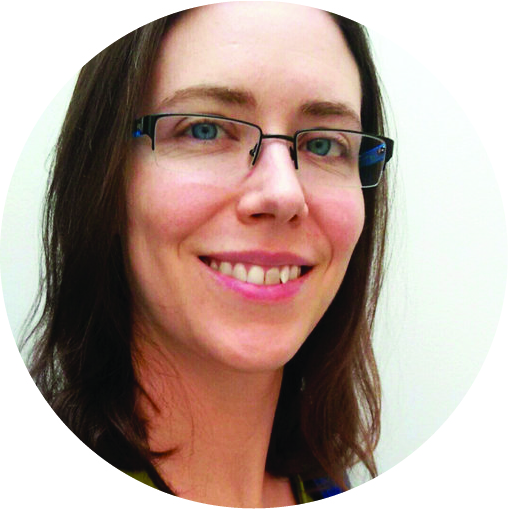 I became an oceanographer by accident; I’m originally from the Prairies! I was working on my MSc in physics, studying fluid dynamics, and looking for ways my research could be relevant to the real world. I met some oceanographers whose work included a focus on climate change and the ocean’s role in the Earth System and I was struck by their passion for what they did; they really felt it mattered and I wanted to be a part of that.
I became an oceanographer by accident; I’m originally from the Prairies! I was working on my MSc in physics, studying fluid dynamics, and looking for ways my research could be relevant to the real world. I met some oceanographers whose work included a focus on climate change and the ocean’s role in the Earth System and I was struck by their passion for what they did; they really felt it mattered and I wanted to be a part of that.
I really like the focus of the UBC Declaration of a Climate Emergency, how it treats climate change as something that touches all areas of our lives and requires solutions that commit to justice for marginalized groups. I think a major challenge is moving from broad areas of action to concrete steps to be taken, and ensuring that those steps go far enough. It can be easy to point to one or two actions as sufficient, but the climate emergency is the defining challenge of our lifetimes - it will require change on a level that we have never seen before. I believe UBC can rise to the challenge, but only if it is treated as an ongoing process of extreme importance. I am hopeful because I see people at all levels engaging seriously in conversations around these challenges and pushing for concrete action. As UBC researchers, we see the impacts of climate change every day in our work, in so many areas. I believe that the UBC community is going to keep demanding change because we know we need it - we know it’s an emergency and we want to face it together!
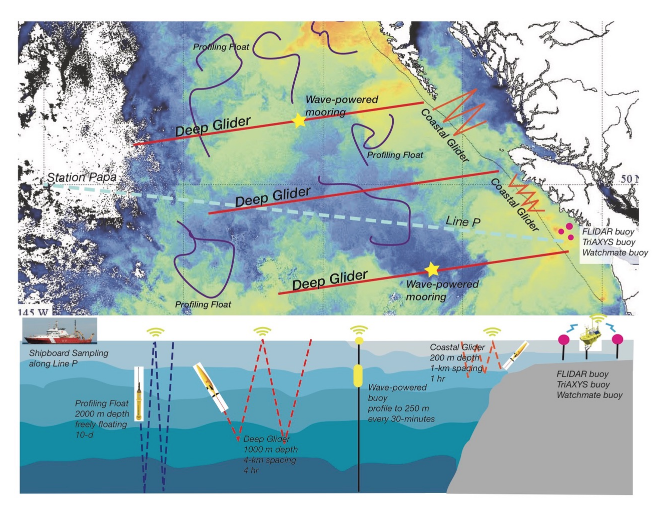
Schematic showing proposed scope of the C-PROOF program. (Top) Sea-surface temperature showing proposed glider monitoring lines (red and orange lines) and wave-powered moorings (yellow stars); sample trajectories of profiling floats (purple lines) and an array of 3 wind and wave buoys (red dots). (Bottom) Not-to-scale side-view schematic showing the typical sampling modes of C-PROOF instrumentation. Operational depths, lateral spacing and repeat times are indicated for each instrument type. Image credit: J. Klymak.
Research
Our oceans are changing at an unprecedented and alarming rate, becoming warmer, more acidic, and more oxygen-limited, with connected and unexpected changes in ocean currents, weather, and marine ecosystems. To quantify and understand the changes and to prepare to adapt to them, we require high-quality, comprehensive observations of the ocean state. However, the oceans are notoriously difficult to sample.
In 2017, a team of oceanographers and ocean engineers from EOAS, the University of Victoria, and Fisheries and Oceans Canada were awarded funds to build a robotic ocean-observing facility to monitor and study BC coastal and offshore waters. We deploy autonomous ocean observing platforms, such as instrumented ocean gliders and profiling floats, to study and monitor BC coastal and offshore waters. These platforms track changes in ocean temperature, salinity and dissolved oxygen, quantify ocean mixing, and measure other biogeochemical ocean properties.
In 2019, C-PROOF achieved the milestone of successfully occupying Line-P, a series of oceanographic sampling stations stretching between the BC coast and Ocean Station Papa - a station in the NE Pacific Ocean that has been routinely sampled by ships since 1959. On its 1400-km journey, the C-PROOF underwater profiling glider “Wall-e” mapped subsurface warmth caused by the recent marine heatwave known as ‘The Blob’. In 2020, the C-PROOF glider “BB” started its occupation of a monitoring line connecting the shallow coastal waters of Queen Charlotte Sound to the deep open-ocean waters beyond the continental shelf, collecting vital oceanographic measurements in the midst of a pandemic. These observations are being used to better understand the mechanisms driving coastal upwelling processes in the region and their important implications for coastal ecosystem health. They will also be used to estimate and explore the ocean carbonate system and ocean acidification in the region.
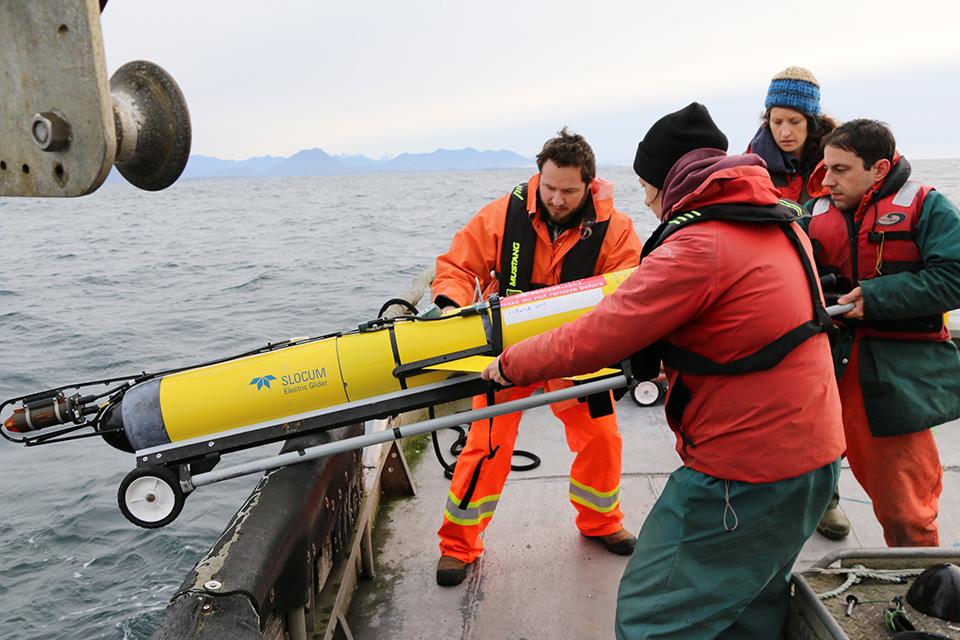
References
https://www.eoas.ubc.ca/news-events/news/1508310000
https://www.hakai.org/storymap/index.html
https://www.eoas.ubc.ca/news-events/news/1569222000
https://hakai.org/gliding-into-the-deep/
https://hakai.org/bbs-first-mission/
https://hakai.org/what-is-upwelling/
Earth’s atmosphere is responsible for redistributing solar energy in the earth/atmosphere/ocean system. The greenhouse effect is part of this redistribution, which drives weather and climate. How will changes in the redistribution (called the energy budget) influence the frequency, severity and distribution of severe storms?
The Birth, Life and Death of Boundary Layer Clouds
Philip Austen, Associate Professor

I am a cloud physicist from Seattle, Washington. I was a physics major interested in environmental problems, and did a summer internship at Woods Hole Oceanographic Institute involving ocean acoustics. Based on that experience, I started graduate school in oceanography at the University of Washington, but midway through my first year I attended a seminar by Marcia Baker on clouds and climate. Her presentation was compelling enough to get me to switch from oceanography and join her cloud physics group.
I think the major challenge facing climate progress will be managing the transition to a carbon neutral economy in a way that raises the standard of living for median-wage workers. Without a positive vision, building a large enough coalition to produce economic changes of the magnitude required is not going to happen. The fact that the United Steel Workers union has joined the BlueGreen Alliance is an example of the kind of coalition building that will determine whether we succeed or fail at implementing policies like the Evergreen Action Plan.
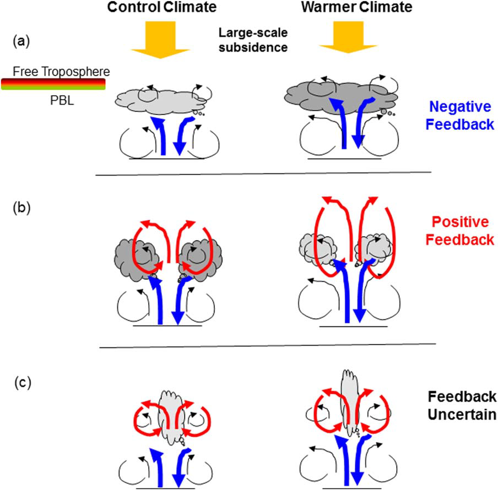
Sketch2 of three different ways boundary layer clouds in current climate models respond to a warming climate: 1) increased cloud cover (stabilizing feedback) 2) reduced cloud cover (amplifying feedback) 3) cancellation (neutral feedback).
Research
The fact that different climate models produce different 50-year forecasts given the same emission scenarios is due largely to differences in the way these models represent clouds, which transport energy and moisture, reflect sunlight and emit longwave radiation back to space1. My research has focused on how clouds mix with their environment and the impact of that mixing on the microphysics (droplets and ice crystals), dynamics (updrafts and downdrafts) and bulk properties (cloud thickness and cloud fraction) of shallow clouds2,3. These boundary layer clouds play a major role in reflecting sunlight over the dark ocean (hence cooling the planet) and transporting energy and moisture into the tropics, where deep convection drives the global atmospheric circulation. They are too thin and too small to be resolved by any climate model, so their behavior has to be “parameterized”; that is, linked to large-scale features that climate models do resolve, such as the average vertical profile of temperature and moisture or the wind speed and direction. The condensation of water vapor into cloud droplets happens in an instant, releases a large amount of thermal energy and produces millions of reflecting and emitting surfaces that completely change the optical properties of the atmosphere. My colleagues and I use detailed computer models of clouds to help bridge the gap between fine scale cloud features and their unresolved effect on the large-scale properties of the atmosphere.
Over 80% of the energy of the atmosphere is transported in the form of water vapor and released in cloudy updrafts. Water vapor is also the dominant greenhouse gas, and clouds determine the strength of the water vapor greenhouse effect by mixing vapor throughout the atmosphere, and removing it via precipitation. The tight coupling between clouds and the global energy and moisture budgets of the atmosphere and ocean, mean that it is extremely hard to develop any intuition about the final effect of all these feedback loops – the history of cloud/climate research over the past forty years has been full of surprises.
References
1Zelinka et al., 2020: Causes of higher climate sensitivity in CMIP6 models, GRL, 10.1029/2019GL085782
2Zhang et al., 2013: CGILS: Results from the first phase of an international project to understand the physical mechanisms of low cloud feedbacks in single column models, JAMES, 10.1002/2013MS000246
3Dawe,J. T. and P. H. Austin, 2013: Direct entrainment and detrainment rate distributions of individual shallow cumulus clouds in an LES, Atmos. Chem. Phys. 10.5194/acp-13-7795-2013
The burning of fossil fuels releases CO2 and other harmful gasses into the environment. These gasses add to the effect of climate change and can be toxic for wildlife, plants and humans. How can we monitor the distribution, rate of spreading, and source of pollution?
Honey as a biomonitor for urban metal distribution
Kate Smith, PhD Candidate and Environmental Chemist
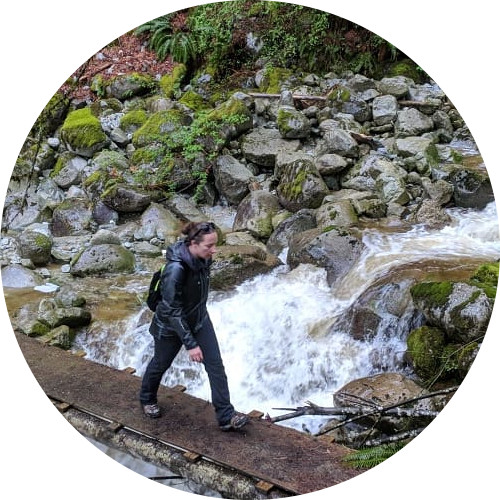
I became an environmental chemist because I am interested in how built environments - especially cities - affect the (bio)geochemical cycling of chemicals like heavy metals, PAHs, PCBs, pesticides, and pharmaceuticals. I believe the main challenges hindering climate action and environmental justice are rapid urbanization and population growth, human displacement due to climate change, and health inequalities. I have hope for climate progress, especially when I see increased funding for environmental and climate research, greening initiatives in cities such as city gardens and careful monitoring of new and legacy pollutants, improved ‘ecodensity’ in cities that maximize space for housing and improve transit systems, and environmental education and outreach, especially for pollutants such as lead (Pb).
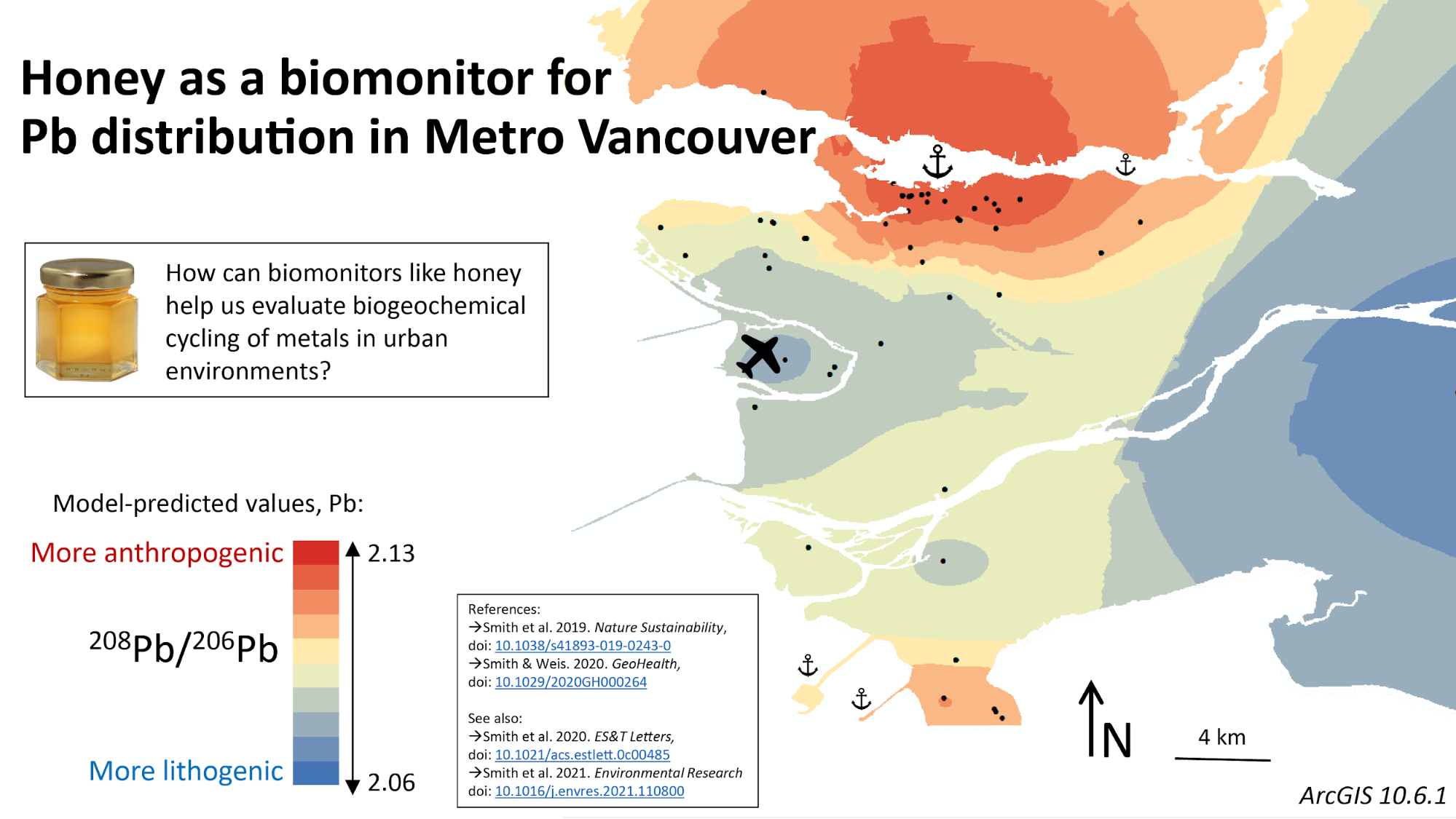
Research
My research explores the impacts of pollution in cities using honeybees as biomonitors. Trace element and isotopic compositions of honey samples (and other bee products) from Metro Vancouver provide chemical snapshots of ~2 km-diameter regions (the range of a typical honeybee). Thus, we can assess small-scale variations in certain elements, and their isotopes, of particular interest to pollution processes. This work is relevant to current critical environmental and agricultural concerns, including climate change (especially in coastal cities), sustainability, food safety, declining pollinator populations and rapid urbanization. The relative affordability of honey sampling and analysis makes this work ideal for adapting and implementing in other cities around the world.
References
Smith, K.E., Weis, D., Amini, M. et al. Honey as a biomonitor for a changing world. Nat Sustain 2, 223–232 (2019). https://doi.org/10.1038/s41893-019-0243-0
Smith, K.E. and Weis, D. 2020. Evaluating spatiotemporal resolution of trace element concentrations and Pb isotopic compositions of honeybees and hive products as biomonitors for urban metal distribution. GeoHealth, 4, e2020GH000264.
Smith, K.E., Weis, D., Chauvel, C., and Moulin, S. 2020. Honey maps the Pb fallout from the 2019 fire at Notre-Dame Cathedral, Paris: A geochemical perspective. Environmental Science & Technology Letters, 2020, 7, 10, 753-759.
Smith, K.E., Weis, D., Scott, S.R., Berg, C.J., Segal, Y., and Claeys, P., (2021) Regional and global perspectives of honey as a record of lead in the environment, Environmental Research,195.
There are natural processes that balance the flow of carbon between the oceans, atmosphere, plants, soil, and rocks. With the increase of CO2 in the atmosphere from the burning of fossil fuels, this balance is upset. How long until natural carbon sinks fill up and what effects will that have on the environment?
Carbonation of the Oman Ophiolite during subduction and emplacement
David Zeko, MSc Candidate
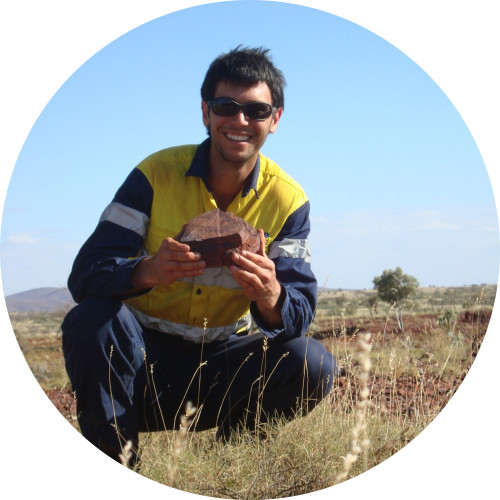
I became a geological scientist to pursue a career where I could follow my curiosity and sense of adventure. I love being outside, learning about the natural world, and visiting new places. One of the main challenges I see towards climate progress is fossil fuel powered transport: the study of geology inherently involves a large amount of travel, often to remote places accessed by aviation. I have hope for progress because of the availability of carbon offsetting schemes and a decision-making framework that considers the need to fly - small changes in the propensity of each person to travel can amount to a significant change collectively.

Stable carbon and oxygen isotope values of carbonates labelled by rock type (symbols) and compared to other carbonates (fields). Green denotes serpentinized and partially carbonated mantle rocks (ophicarb) while maroon and purple denote the fully carbonated mantle rocks known as listvenite (list). Progressive carbonation results in the dilution of the mantle carbon isotopic signature (green circles with negative values) by the marine calcite signature (blue circles and triangles with low positive values). Isotopes also indicate that the underlying metamorphic rocks (meta) are a likely source of the carbon dioxide. The field for meteoric and cryptocrystalline magnesite is from Quesnel et al. (2013), mantle carbonatites from Deines (2002) and marine calcite from Qing and Veizer (1994). w.r = whole-rock, mtx=mgs and vn = vein.
Research
Ultramafic rocks are rich in metals such as magnesium and iron and have the ability to absorb large amounts of carbon dioxide by forming stable carbonate minerals such as magnesite. In the Sultanate of Oman, ultramafic rocks that formed deep below oceanic crust were tectonically thrust onto land. During this process, billions of tonnes of carbon dioxide was sequestered through mineral carbonation. My research shows that mineral carbonation in Oman proceeded via a series of chemical reactions that broke down minerals in the oceanic crust, such as olivine and orthopyroxene, to form new minerals such as talc, magnesite and dolomite. These reactions were driven by two pulses of carbonating fluids that originated from carbonate-bearing metamorphic rocks immediately below. The carbonating fluids varied in temperature between 50 and 250 ℃ and contained upwards of 0.01% carbon dioxide. These conditions could be replicated in engineered mineral carbonation systems to sequester CO2.
References
Deines, P. (2002). The carbon isotope geochemistry of mantle xenoliths. Earth-Science Reviews, 58(3), 247–278. https://doi.org/https://doi.org/10.1016/S0012-8252(02)00064-8
Qing, H., & Veizer, J. (1994). Oxygen and carbon isotopic composition of Ordovician brachiopods: Implications for coeval seawater. Geochimica et Cosmochimica Acta, 58(20), 4429–4442. https://doi.org/https://doi.org/10.1016/0016-7037(94)90345-X
Quesnel, B., Gautier, P., Boulvais, P., Cathelineau, M., Maurizot, P., Cluzel, D., Ulrich, M., Guillot, S., Lesimple, S., & Couteau, C. (2013). Syn-tectonic, meteoric water–derived carbonation of the New Caledonia peridotite nappe. In Geology (Boulder) (Vol. 41, Issue 10, pp. 1063–1066). Geological Society of America, Inc. https://doi.org/10.1130/G34531.1
Even as scientists came to recognize the emerging impacts of anthropogenic climate change, increasing evidence was gathered for the many ways in which Earth’s climate has varied in the distant past - from cycles of ice ages to the causes and effects of mass species extinction events. What were the processes driving past changes in Earth’s climate, and what were the conditions that allowed Earth to develop a habitable climate in the first place?
Constraining the sensitivity of landscapes, surface processes and terrestrial sedimentary archives to past climate changes
Mitch D’Arcy, Assistant Professor

I am a geomorphologist and assistant professor from London, England. I became a geomorphologist so I could address fundamental geoscience questions that span the disciplines of plate tectonics, climate science, and palaeoclimate, and involve a range of methods including field-based mapping and geomorphology, theoretical models, geochemistry, and remote sensing. My primary aim is to understand how climate changes in the past have impacted Earth’s surface processes, landscapes, and terrestrial sedimentary deposits.
Research
My research aims to understand how past climate changes have affected Earth’s surface. I focus on constraining how sediment production, transport and deposition have reacted to changes in hydroclimate associated with Earth’s orbital cycles. The influence of climate on surface processes has important implications for our understanding of how sensitive landscapes are to climate change, how palaeoclimate signals get transmitted into stratigraphic archives, and how we can use sedimentary records to reconstruct Earth’s past climate states.
Earth’s climate has changed throughout its history, over many different timescales and in a variety of ways. It’s exciting to be able to read geological records of Earth’s evolution, and I find ancient climate changes particularly fascinating. It’s important that we have a strong, fundamental understanding of ancient climate changes and their consequences for the Earth’s surface. These events offer clues about how anthropogenic climate changes in the future could impact the landscapes we live and depend on.
